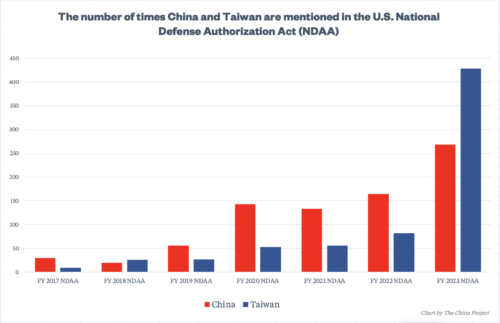China is all over the 2023 Pentagon Budget
The U.S. defense budget for 2023 has been approved, and it has removed some earlier provisions that were sure to anger Beijing. But the legislation still has China firmly in its sights.

Today U.S. President Biden signed the mammoth National Defense Authorization Act (NDAA) for the fiscal year 2023 — and China is one clear focus of the record-breaking $858 billion Department of Defense (DOD) budget.
The bill allocates $11.5 billion in funding for objectives outlined in the Pacific Deterrence Initiative, part of a broad effort to counterbalance China, up from $7 billion in fiscal year 2022. In addition, the bill authorizes up to $10 billion for Taiwan over five years in military grants and loans, and sets Chinese semiconductor firms in its sights.
China, as well as Russia, got an early call-out in the Senate Armed Services Committee’s (SASC) 18-page summary of the legislation, which listed strategic competition with the two nations as a top defense priority. Also among the list of key security issues was development of emerging technologies such as hypersonic weapons, artificial intelligence (AI) and quantum computing, areas China also frequently cites as top concerns.
The full text of the bill gives a fuller perspective on policymakers’ heightened sense of a challenge from China. The bill contains 268 mentions of China and 428 mentions of Taiwan, compared to the 164 China mentions and 82 Taiwan mentions of the fiscal year (FY) 2022 NDAA. (The FY 2017 NDAA, by contrast, had 30 mentions of China and 9 of Taiwan, reflecting the marked shift in the Pentagon’s focus over the past several years.)

The legislation also requires the U.S. government to begin providing a wealth of new reporting on China. Some of these include reports on corruption among Chinese leaders (including Xí Jìnpíng 习近平), state efforts at censorship and intimidation of U.S. persons, and attempts from the PRC to buy land near U.S. military facilities. The DOD must now also track American sourcing of contractor-provided rare earth elements, the production of which China has dominated for years. China has in the past sought to weaponize its rare earth production, and in 2010 cut Japan off of rare earth exports over a maritime dispute.
A military boost for Taiwan
Included in this year’s NDAA is the Taiwan Enhanced Resilience Act, or TERA — an updated version of the earlier Taiwan Policy Act which intended to bolster the U.S.-Taiwan relationship. The Taiwan Policy Act had included various provisions that were perceived as highly provocative toward China, such as renaming Taiwan’s de facto embassy in the U.S. from the Taipei Cultural and Economic Representative Office (TECRO) to the Taiwan Representative Office.
Beijing is unlikely to welcome TERA, however, which authorizes funding of up to $2 billion per year through 2027 in military grants and loans for Taiwan under the federal Foreign Military Financing (FMF) program, giving U.S. legislators the option to sharply increase that support in the years ahead. But the authorization does not guarantee Taiwan will actually see the military aid: Additional appropriating legislation will be necessary for the military assistance to actually reach the self-ruled island. While Taiwanese officials in Washington are pushing for the assistance to be provided in grants, top U.S. appropriators hope to provide the assistance in loans to be paid back over a 12-year period, Defense News reported.
Evan Medeiros, former senior director for Asian Affairs at the National Security Council under President Obama, told The China Project that Beijing has likely anticipated the U.S.’s ramping up of military assistance to Taiwan. “It just further confirms Beijing’s view that the U.S. is on the trajectory to increasing its defense ties with Taiwan and, in Beijing’s view, recreating a de facto military alliance,” he said. “So it’s significant, but it’s not surprising to Beijing.”
Medeiros joined a delegation to Taiwan from the Washington-based Center for Strategic and International Studies (CSIS) last week which met with Taiwan’s President Tsai Ing-wen (蔡英文 Cài Yīngwén) and discussed the U.S.-Taiwan security relationship, among other issues.
“Taiwan understands what it needs to do, but executing it is a huge challenge” — Evan Medeiros
Speaking about the trip, Medeiros said one key focus in the discussions was about how the U.S. can help Taiwan move towards a more “whole-of-society” posture when it comes to defending against a potential attack from China. “Taiwan understands what it needs to do, but executing it is a huge challenge,” he said. “For example, mandatory military service now is only four months, and they’ve proposed moving it up to one year, but it’s politically controversial.”
Taiwan-related provisions in the NDAA, like TERA, could be one piece of that puzzle. In addition to the FMF authorizations, TERA authorizes $1 billion in presidential drawdown authority, which allows the U.S. to rapidly provide military assistance to other countries in times of emergency. The legislation also requires the U.S. and Taiwan to cooperate on carrying out a multi-year military training program.
But some observers are unsure if higher levels of funding will be enough to deter a Chinese attack. Lyle Goldstein, the Director of Asia Engagement at the think tank Defense Priorities and a visiting professor at Brown University, told The China Project that there is still a stark mismatch in resource allocation between Taiwan and China, which spent close to $300 billion on defense in 2021. The same year, Taiwan spent $15.9 billion on defense.
“It doesn’t really change the picture of Taiwan’s defense budget, which honestly remains very low in relation to the threat,” he said. “It’s not even in the same universe as what China is spending, obviously.”
The wrong weapons?
Goldstein also noted that Taiwanese military decision-makers don’t always invest in the weapons that would most effectively counter Chinese threats, opting instead to go with more impressive or prestigious technologies.
“There’s incredible bureaucratic and prestige incentives on the island to go with those big ticket items,” he said. “And there are some here too — let’s face it, the American arms manufacturers make more money from selling an F-16 than they do from selling a Stinger missile system.”
The Biden administration is attempting to shape Taiwan’s arms purchase requests in order to alleviate this issue. It has urged Taiwan to buy an up-to-date version of a mobile artillery system it previously ordered, and denied a request for a helicopter meant for maritime surveillance.
Hypersonic missile defense for America
The NDAA includes provisions for nearly $300 million toward development of a special hypersonic missile defense system known as a glide-phase interceptor, as well as increased funding for research, development, test, and evaluation (RDT&E) around hypersonic missile defense. “This basically more than doubles the hypersonic defense budget,” Masao Dahlgren, an Associate Fellow at the Center for Strategic and International Studies (CSIS), told The China Project.
American defense officials and lawmakers have grown increasingly apprehensive about China’s hypersonic developments, especially after China tested an orbital hypersonic missile system in 2021, which the U.S.’s top defense official Mark Milley likened to the Cold War’s “Sputnik Moment.” The innovation could allow China to send hypersonic missiles over the South Pole to approach the U.S. from unexpected directions, complicating the ways Washington could counter such an attack.
In addition to hypersonic weapons, Dahlgren emphasized the high quantity of China’s fielded ballistic missile threats. “We can talk about the leading edge of hypersonic technology, but the sheer volume of ballistic threats in the region itself I think is a huge issue, so when I’m scoping things I would bring it back to that,” he said, adding that he believed the U.S. military was investing in ways to counter ballistic missiles that could target naval assets in the Indopacific.
“I think the DOD investments reflect a strategy to counter China’s proliferation of [ballistic] missiles within the first island chain,” he said. “Investments in long-range bombers, in aerial refueling, in means to reduce the signature of surface warships and carriers, investments in submarines and things that are highly survivable, I think reflect an understanding of the problem.”
Yet more curbs on Chinese chipmakers
As technological competition increases between the U.S. and China, the NDAA sets a few specific Chinese semiconductor firms in its sights, and contains broader language to further boost the U.S.’s own position when it comes to chips. The legislation calls out Semiconductor Manufacturing International Corporation (SMIC), Yangtze Memory Technologies Corp (YMTC), and ChangXin Memory Technologies (CXMT), and bans government entities from buying and using chips made by the Chinese firms in “critical systems.”
However, the bans are not as strict as some had anticipated. The final legislation waters down previously proposed restrictions on the companies by exempting government contractors and some sections of the government from stripping their systems of chips made by the three companies. It also pushes the implementation deadline back from two to five years.
Lawmakers scaled back the restrictions on the Chinese firms due to practical difficulties government agencies would face in removing products made by the companies from all of their systems.
“Scoping it down to ‘critical systems’ is a logical step, but still represents a big compliance conundrum,” Reva Goujon, a director at the research firm Rhodium Group, told The China Project. “Electronics manufacturers are not in the habit of listing out every production source of every input contained in devices, and [the] government simply doesn’t have as much transparency into electronics supply chains as it would like.”
“We still have to see how ‘critical systems’ ends up being defined, as well,” she added.
The NDAA legislation is just one of the restrictions and sanctions the U.S. has piled on to Chinese semiconductor firms in recent months, hampering the ability of Chinese firms to produce chips, the building blocks of modern electronics. In October, the U.S. announced sweeping export controls targeting Chinese semiconductor firms. In some cases, they restricted the ability of non-U.S. firms to do some types of business with Chinese chip companies through a regulation known as the foreign direct product rule (FDPR) — which was first used to crack down on Chinese telecom giant Huawei during the Trump administration, and later against Russia after its invasion of Ukraine. The U.S. also took measures that led to YMTC landing on the Commerce Department’s Entity List (where SMIC has been listed since December 2020), further restricting American firms from doing business with the company.
The measures are partly meant to keep China from moving up the value chain in the industry, preserving and extending the U.S.’s lead in producing many of the most advanced computer chips.
The race is on
The newly signed NDAA continues to take the U.S. down a clear trajectory of competition with China, including increasing funding for priorities in the Indo Pacific, setting up new types of security cooperation with Taiwan, and countering Chinese efforts like hypersonic weapons.
While the final legislation omitted some of the most hawkish provisions lawmakers had proposed, especially around Taiwan, Beijing is likely to see this as a doubling down by the U.S. on overall strategic competition. At a time when China faces challenges like the spread of COVID-19 and fallout in the real estate sector, Beijing’s response to the U.S. efforts to counter its security and technological landscape in the Indo Pacific remains to be seen.






